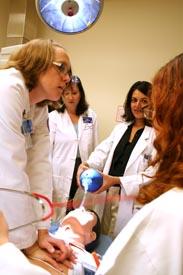Internist Shows Effectiveness of Simulation-Based Training
 A patient named “Cosmo” has taught Feinberg School of Medicine faculty member Diane Bronstein Wayne, MD ’91 (shown second from left), much about medical education and the power of research. He has made her an award winner too. The Society of General Internal Medicine bestowed upon this associate professor of medicine the organization’s National Award for Scholarship in Medical Education at its annual meeting in Toronto in late April. The honor recognized Dr. Wayne’s research documenting the benefits of simulation-based training of internal medicine residents and its overall positive affect on patient care.
A patient named “Cosmo” has taught Feinberg School of Medicine faculty member Diane Bronstein Wayne, MD ’91 (shown second from left), much about medical education and the power of research. He has made her an award winner too. The Society of General Internal Medicine bestowed upon this associate professor of medicine the organization’s National Award for Scholarship in Medical Education at its annual meeting in Toronto in late April. The honor recognized Dr. Wayne’s research documenting the benefits of simulation-based training of internal medicine residents and its overall positive affect on patient care.
A clinician and residency program director, Dr. Wayne never dreamed that she—with no formal research training—would someday receive a research award. “My career went in a slightly different direction than I thought it would go,” she says. “I intended to take care of patients and run the residency program—research was not at the forefront of my plan.”
Dr. Wayne’s initial study comparing patient simulatorâbased educational intervention with clinical experience alone in the training of second-year residents and their subsequent application of advanced cardiac life support (ACLS) protocols all began innocently enough. “A few years ago [department chair] Larry Jameson suggested I take a look at the patient simulator [nicknamed “Cosmo”] in the Department of Anesthesiology,” recalls Dr. Wayne. “After checking it out, I thought it could be fun for residents to practice their ACLS skills on Cosmo.” Highly sophisticated teaching tools, today’s patient simulators like Cosmo can bleed, urinate, and demonstrate human vital signs. They can even “talk” with the help of a microphone and a nearby medical educator who monitors the medical intervention and adds some realism to the situation.
All internal medicine residents, in the course of their training, must demonstrate competency in ACLS procedures. Required for board certification, knowledge of ACLS protocols usually comes into play in acute situations where patients exhibit, for example, symptoms of cardiac distress and need immediate and basic life support. For the purposes of education, however, these scenarios don’t follow a set schedule and thus make practical hands-on experience difficult to obtain.
“For these events to occur on a clinical service is actually rare,” explains Dr. Wayne. “So when I saw the simulator, ACLS skills immediately came to my mind because those are critical procedures to practice.”
The current standard nationwide for learning ACLS skills involves taking a one-day course approved by the American Heart Association. Dr. Wayne and her colleagues studied the effectiveness of simulation-based training on this particular skill set by first gathering baseline data from 38 second-year residents. Then randomized into two groups, some residents received four two-hour simulator teaching sessions while the others were placed on a wait-list and became the control group.
The two groups did not differ in their ACLS knowledge at baseline. When the researchers tested the residents who had practiced their skills on Cosmo, they found that these individuals’ ACLS performance improved by 38 percent over the group who had not received the additional training. The investigators replicated their results with the second group of trainees once they had had an opportunity to work with the patient simulator. The study not only demonstrated the effectiveness of simulation-based training but also earned accolades from residents who gave the educational program high marks, according to Dr. Wayne.
The research expanded to a follow up of long-term retention of ACLS skills. Residents who underwent simulation-based training in Dr. Wayne’s study could recall and use what they learned up to 14 months after practicing with Cosmo. “Most literature about standard ACLS training suggests that it does not promote skill attainment and retention and that as soon as people take the course, they usually forget much of what they have learned,” says Dr. Wayne. “While we still have our residents take the standard ACLS training course, they also spend time with Cosmo.”
Given their success using simulation-based training to enhance proficiency with ACLS protocols, Dr. Wayne and her fellow medical education investigators are now looking at other procedures such as thoracentesis and central venous catheter insertion. Her research team consists of several faculty members in the Departments of Medicine and Anesthesiology including John E. Butter, MD, assistant professor of medicine, and Leonard D. Wade, MS, assistant professor of anesthesiology.
Publishing and becoming a leader in this innovative area of medical education has given Dr. Wayne new appreciation for the world of research. She credits her good fortune to finding an excellent mentor in William C. McGaghie, PhD, professor, Office of Medical Education and Professional Development, and of preventive medicine. “When I first thought about using simulation-based training with our residents,” says Dr. Wayne, “Bill suggested that I make whatever I did academically productive. So I did and discovered that through research you can ultimately make a much bigger impact on the quality of patient care. That has been extremely rewarding.”
Posted May 31, 2007






